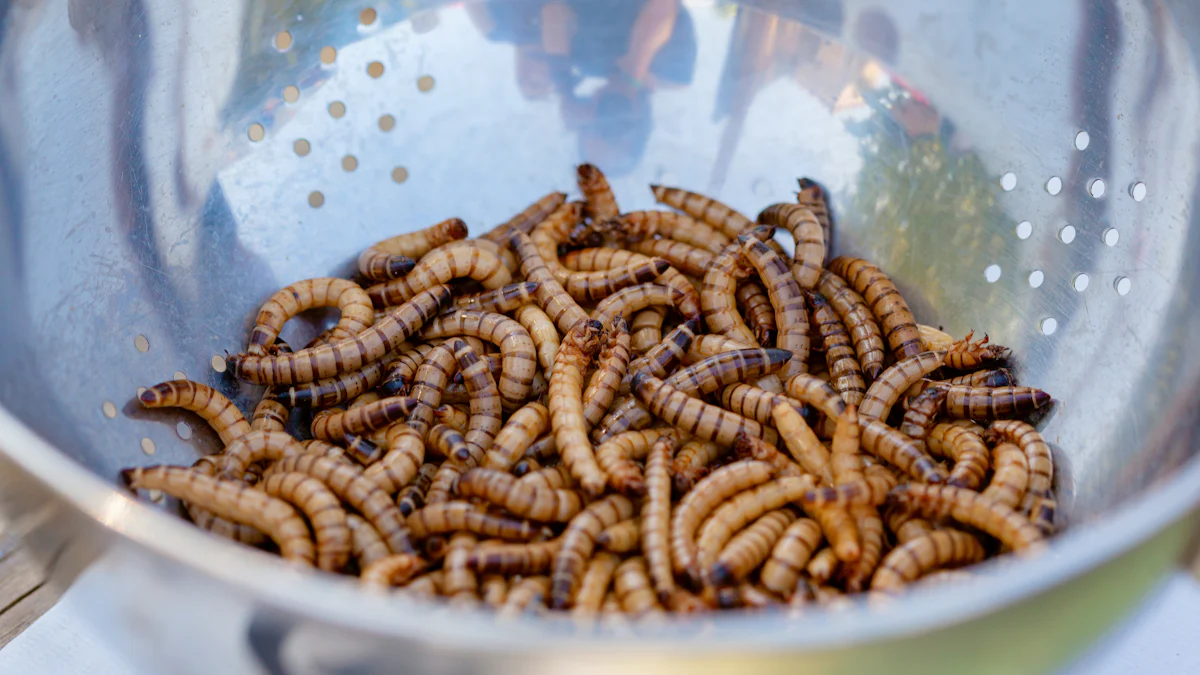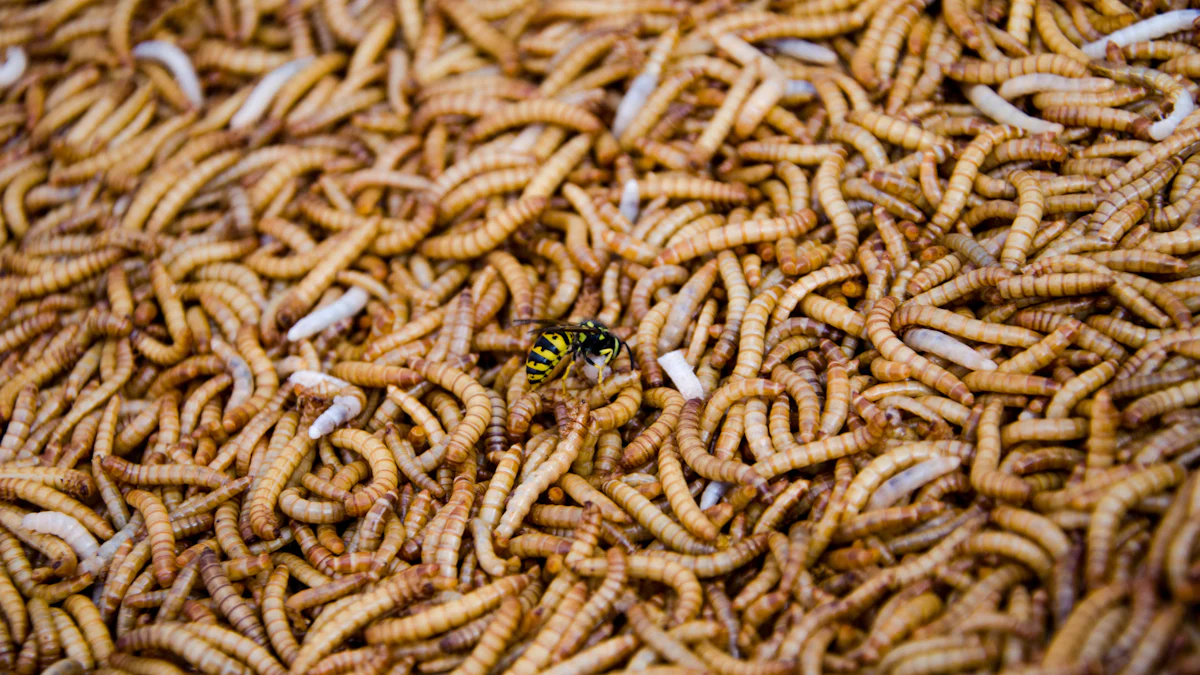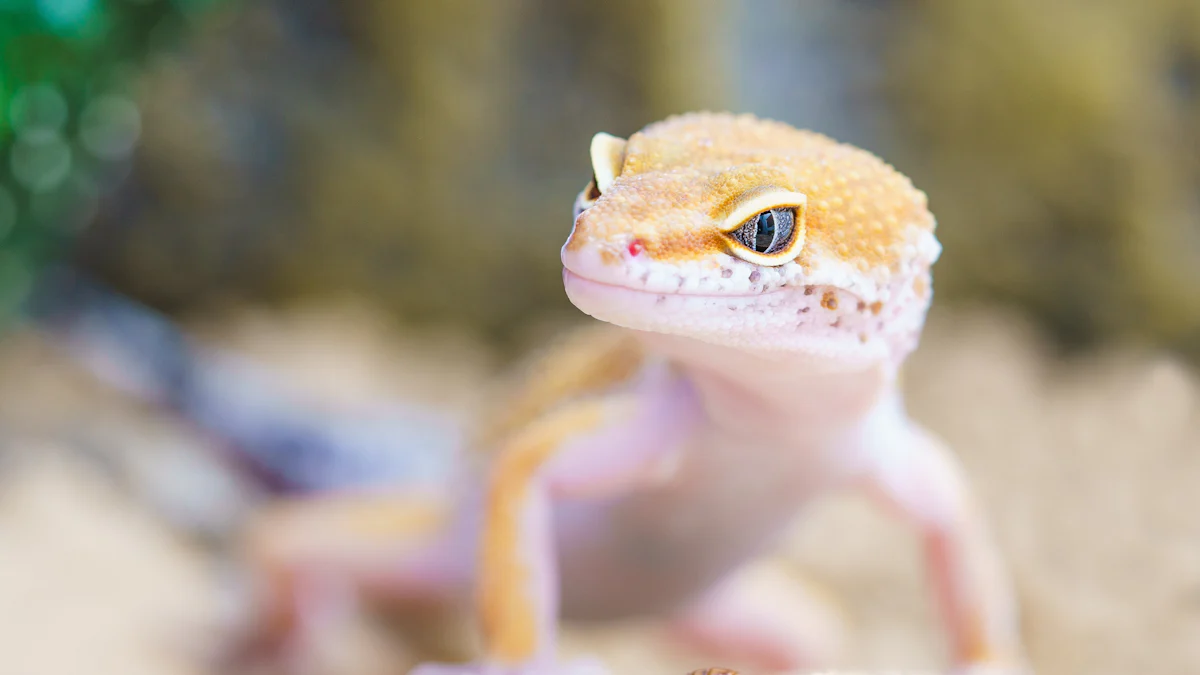
Mealworm reptile food is a fantastic choice for many reptiles. I’ve seen geckos, bearded dragons, and even turtles thrive on mealworm reptile food. Why? It’s packed with protein, healthy fats, and essential vitamins. Plus, it’s easy to prepare and feed. Mealworm reptile food isn’t just for reptiles either—they’re also used as bait and bird food. Pretty versatile, right? But not all reptiles can handle mealworm reptile food, so it’s important to know what’s safe.
Key Takeaways
- Mealworms are a healthy food for many reptiles. They give protein, good fats, and vitamins for energy and growth.
- Some reptiles cannot eat mealworms safely. Reptiles with weak digestion should avoid them to stay healthy.
- Always prepare mealworms by feeding them nutritious food and adding supplements. This makes them healthier and prevents nutrient problems.
Reptiles That Can Eat Mealworms

Common Reptiles That Eat Mealworms
Mealworms are a favorite among many reptiles. I’ve personally seen how much certain species enjoy them. Here’s a quick list of reptiles that commonly eat mealworms:
- Bearded dragons
- Leopard geckos
- Crested geckos
- Veiled chameleons
- Blue-tongue skinks
- Green basilisks
These reptiles thrive on mealworm reptile food because it’s packed with protein and healthy fats. It’s also fun to watch them hunt live mealworms, which keeps them active and mentally stimulated. For example, my leopard gecko loves chasing mealworms around its enclosure. It’s like a mini workout for him!
Species-Specific Considerations for Mealworm Feeding
Not all reptiles have the same dietary needs, so it’s important to know what works best for your pet. Bearded dragons, for instance, need protein for growth, and mealworms are a great source. They’re also rich in fats, which provide energy. For chameleons, live insects like mealworms are essential for proper development. However, gut-loading and dusting mealworms with supplements are key to meeting their nutritional needs.
Leopard geckos benefit from the higher calorie content of mealworms compared to other insects like crickets. This helps them grow faster and stay healthy. I always make sure to mix mealworms with other insects to give my gecko a balanced diet. Variety is crucial to prevent nutritional deficiencies.
Reptiles That Should Avoid Mealworms
While mealworms are great for many reptiles, they’re not suitable for all. Some reptiles struggle to digest mealworms because of their high chitin content. This can lead to digestive issues or even impaction, which is a serious health problem. I’ve heard of cases where reptiles passed undigested mealworms, a clear sign of poor digestion.
If your reptile has a sensitive digestive system, it’s best to avoid mealworms. Instead, consider softer feeder insects like waxworms or silkworms. Always monitor your pet’s health and adjust its diet as needed.
Nutritional Benefits and Risks of Mealworm Reptile Food
Key Nutrients in Mealworms
Mealworms are a powerhouse of nutrition for reptiles. I’ve always appreciated how they pack so much goodness into such a small package. They’re loaded with high-quality protein, which helps reptiles build strong muscles and stay active. Mealworms also provide essential amino acids that support overall health.
What’s more, they’re rich in B vitamins. These vitamins are crucial for energy and keeping the nervous system in top shape. I’ve noticed that reptiles fed mealworms tend to stay more energetic and alert. Mealworms also contain important minerals like calcium and phosphorus. These minerals are vital for strong bones and proper muscle function.
Potential Health Risks of Mealworms
While mealworms are nutritious, they come with a few risks. Their hard exoskeleton can cause impaction, especially in reptiles with sensitive digestive systems. Impaction is a serious issue that can even lead to death in some cases.
Mealworms may bite while being swallowed, potentially causing internal injuries.
Another thing I’ve learned is that the quality of mealworm reptile food depends on what the mealworms eat. If they’re raised on low-nutrition bedding, they won’t provide the nutrients your reptile needs. Feeding mealworms exclusively can also deprive reptiles of a balanced diet. Most reptiles need a variety of insects to thrive.
Comparing Mealworms to Other Feeder Insects
Mealworms stand out for their high protein and fat content. Compared to dubia roaches, they’re a richer source of energy. However, their calcium-to-phosphorus ratio (1:11.8) isn’t ideal. Dubia roaches, with a balanced ratio of 1:1.01, are better for reptiles needing more calcium.
Mealworms are easier to digest than dubia roaches because of their lower fiber content. This makes them a good choice for reptiles that struggle with tougher insects. I like to mix mealworms with other feeder insects to give my reptiles the best of both worlds.
Feeding Methods and Best Practices

Preparing Mealworms for Feeding
Before feeding mealworms to reptiles, I always make sure they’re prepped properly. It’s not just about grabbing them and tossing them into the enclosure. First, I gut-load the mealworms with nutrient-rich foods like leafy greens or carrots for 24-48 hours. This step boosts their nutritional value, making them healthier for my reptiles. I also avoid foods high in phosphorus since they can interfere with calcium absorption.
Once the mealworms are gut-loaded, I let them warm up for about 30 minutes to an hour. Cold mealworms can be sluggish, and reptiles prefer active prey. Right before feeding, I dust the mealworms with calcium and vitamin supplements. This ensures my reptiles get the essential nutrients they need, especially calcium, which is crucial for strong bones.
Feeding Frequency and Portion Sizes
When it comes to feeding, I stick to a schedule. For adult reptiles, I offer mealworms two to three times a week. Juveniles, on the other hand, need more frequent feedings to support their growth. Portion sizes depend on the reptile’s size and appetite. For example, my leopard gecko eats about 5-7 mealworms per feeding, while my bearded dragon can handle 10-15.
Overfeeding is a big no-no. Too many mealworms can lead to obesity or nutritional imbalances. I always monitor my reptiles’ weight and adjust portions as needed.
Gut-Loading and Dusting Mealworms
Gut-loading and dusting are non-negotiable for me. Most feeder insects, including mealworms, lack sufficient calcium and vitamins. Gut-loading fills this gap by feeding the mealworms a nutrient-rich diet before offering them to reptiles. Dusting, on the other hand, involves coating the mealworms with supplements like calcium powder.
I’ve learned that gut-loading alone isn’t enough. Combining it with dusting ensures my reptiles get a balanced diet. This practice helps prevent nutritional diseases like metabolic bone disease, which can be life-threatening. It’s a simple step that makes a huge difference in their health.
Precautions and Limitations
Risks of Impaction and Prevention Tips
Impaction is one of the biggest risks when feeding mealworms to reptiles. Their hard exoskeletons can be tough to digest, especially if your reptile eats too many. I’ve seen cases where reptiles stop eating or pooping because of impaction, and it’s heartbreaking. But don’t worry—there are ways to prevent this.
Here’s what I do to minimize the risk:
- I feed freshly molted mealworms. These are softer and much easier for reptiles to digest.
- I always keep my reptiles hydrated. Proper hydration helps their digestive system work smoothly.
- I place mealworms in a bowl instead of directly on the substrate. This prevents accidental ingestion of substrate, which can worsen impaction.
Tip: A balanced diet is key. Mixing mealworms with other softer insects like waxworms can reduce the chances of impaction.
Signs of Overfeeding or Nutritional Imbalance
Overfeeding mealworms can lead to serious problems. I’ve noticed that reptiles fed too many mealworms often become obese, especially if they’re not very active. Sedentary species like savannah monitors and tegus are particularly prone to this.
Here are some warning signs I look out for:
- My reptile stops eating or pooping. This could mean impaction.
- Weight gain or visible fat deposits, especially around the tail or belly.
- Lethargy or lack of energy.
Feeding only mealworms can also cause nutritional deficiencies. Reptiles need a variety of insects to meet all their dietary needs. I always mix mealworms with other options like crickets or silkworms to keep my pets healthy.
Why Some Reptiles Should Avoid Mealworms
Not all reptiles can handle mealworms. Their hard exoskeletons can cause impaction or even internal injuries if swallowed whole. I’ve learned that reptiles with sensitive digestive systems, like young or sick reptiles, should avoid mealworms altogether.
For these reptiles, I recommend softer alternatives like waxworms, butterworms, or silkworms. These insects are easier to digest and provide a good balance of nutrients. Freshly molted mealworms can also work in some cases, but I always monitor my pet’s feeding habits closely to avoid any issues.
Note: Always consult a vet if you’re unsure about your reptile’s diet. It’s better to be safe than sorry!
Mealworm reptile food is a fantastic option when fed responsibly. It’s packed with protein, vitamins, and minerals that keep reptiles healthy and active. I’ve seen how a balanced diet, including mealworms, supports muscle growth and energy. In 2025, I expect advancements like softer exoskeletons and improved gut-loading techniques to make mealworms even better for reptiles.
Tip: Always tailor your reptile’s diet to its specific needs. A little effort goes a long way in keeping them happy and thriving!
FAQ
Can I feed mealworms to wild reptiles or birds?
Yes, you can! Wild reptiles and birds love mealworms. I’ve seen birds especially enjoy them during nesting season. They’re a great protein source. 🐦
How do I store mealworms to keep them fresh?
I keep mine in a cool, dry place, like the fridge. This slows their growth and keeps them alive longer. Just avoid freezing them! ❄️
Are mealworms safe for baby reptiles?
Not always. Baby reptiles struggle with mealworms’ hard exoskeletons. I recommend softer options like waxworms or freshly molted mealworms for easier digestion.
Tip: Always consult a vet if you’re unsure about your pet’s diet. It’s better to be safe than sorry!


